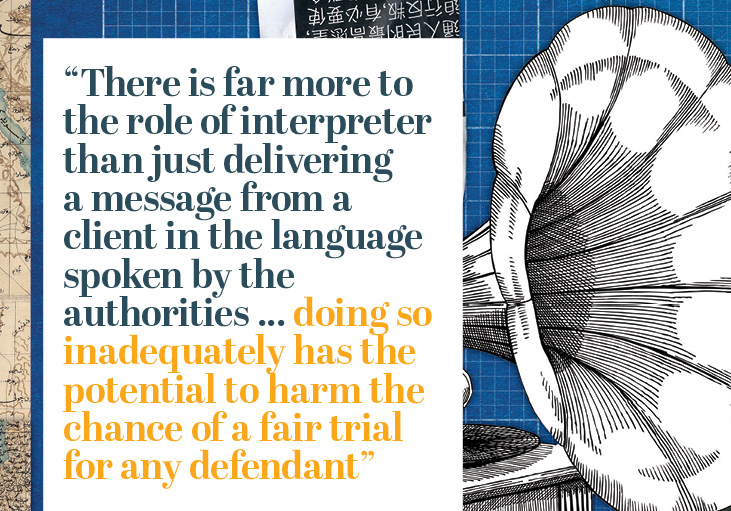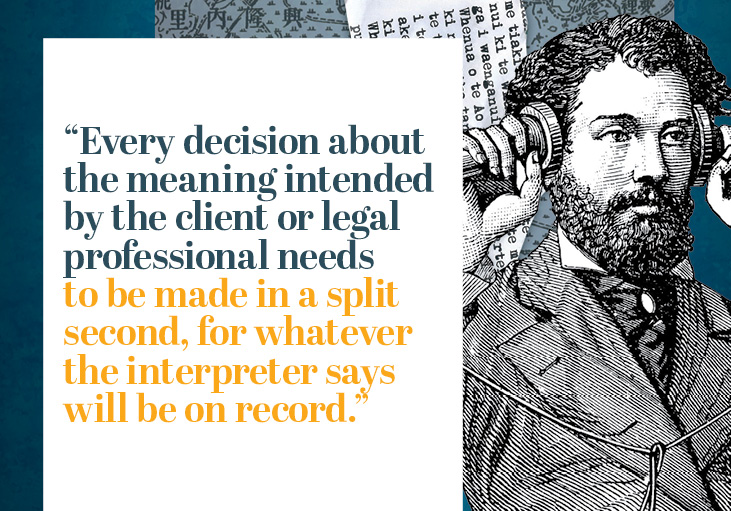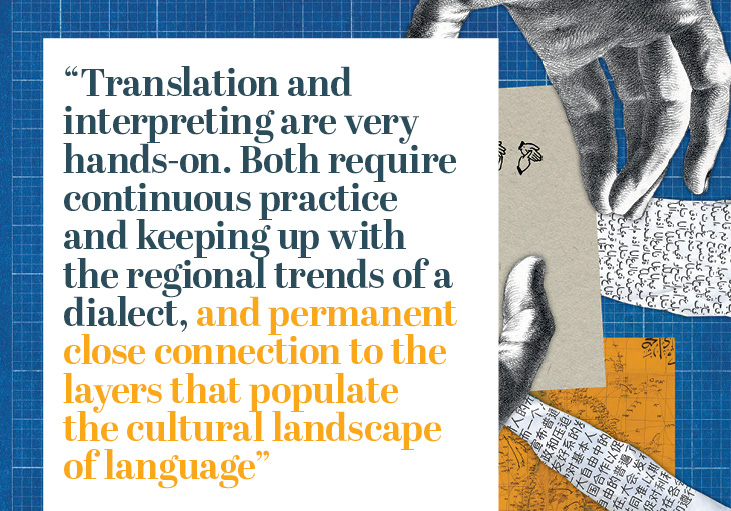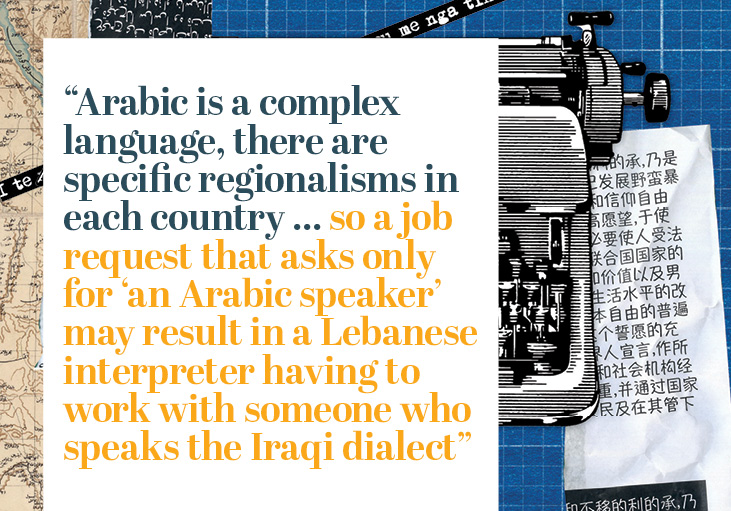- Home
- Round Table
- 2023
- Lost in Translation
Lost in Translation
Jul 20, 2023
Essential for facilitating access to justice for immigrants and others including the Australian Deaf community, interpreters working in the justice system face the pressures of unreliable work and a lack of trust from the same legal professionals who require their expertise. Recommended Standards promise to improve work practices, but will they be enough to ensure the service maintains the high quality that justice demands?
A Portuguese witness questioned in court recounts walking past a young girl —a “rapariga”— as an essential detail of the case. The Brazilian interpreter is also a native speaker of the language, but, lacking experience, he misses a slight cultural difference between the two dialects, so his translation to the jury references what the word “rapariga” means to him: a sex worker.
Angelo Berbotto chuckles when he hears this anecdote. It may just be an urban legend, but the situation is only too familiar to him. As are the implications of a culturally misaligned translation on a client’s full access to justice.
Berbotto is a solicitor and a translator, currently completing his Master’s degree in legal interpreting. Fluent in five languages, born in Uruguay, he first moved to the UK, where he practised as a solicitor before moving permanently to Australia.
‘The misunderstood profession’
“I like the law, but I don’t want to be a lawyer full time. It means always taking on people’s problems, especially as I’ve always worked in child protection.” Berbotto considers himself a part-time lawyer and full-time translator, and is aware of his privileged position as someone who understands both roles fully. He calls interpreting “the misunderstood profession”: giving a voice to those whose mastery of the English language is insufficient, and whose cultural practices need to be decoded. Immigrants, refugees, the Australian Deaf community and Indigenous people who speak English as a second language — the interpreter is their voice.
But that voice can be heard only under the right conditions. Without strong support for good interpreters, and working conditions that optimise their contribution, justice cannot be accessible to all.
In 2018, the National Accreditation Authority for Translators and Interpreters (NAATI) introduced a system of certification levels, including a Certified Specialist Legal Interpreter (CSLI), assessed through a legal knowledge test and a series of proficiency scenarios, with the added requirement of mandatory continuous development.
“Before 2018, once you got accredited, you got your practice certificate for life,” Berbotto tells the Law Society Journal. “The problem with that system was that many people were stagnating. They were not looking after their skills. Language changes, and if you don’t work on it, your level of proficiency goes down.”
The change was welcomed by a profession fighting to be recognised and respected in the legal world. The primary misconception of many solicitors is that interpreting is a service that anyone with proficiency in a particular language can deliver. Berbotto earnestly explains that there is far more to the role of interpreter than just delivering a message from a client in the language spoken by the authorities, and that doing so inadequately has the potential to harm the chance of a fair trial for any defendant.

“Somebody facing a trial looks up to the interpreter because they speak the same language. But the allegiance of the interpreter is to the language, the message. The message has to be conveyed accurately,” Berbotto says. He explains that this means not just the semantics of the words, but the linguistics also; think of the hidden meaning, the subtle touch that makes an Australian ‘yeah, nah’ actually mean ‘no’.
A bilingual person who hasn’t been trained is more likely to make mistakes or not understand the weight a phrase has in a culture. As the anecdote at the start of this article illustrates, it makes a big difference to know what a word means in one regional dialect compared with another.
Berbotto describes the role of an interpreter as that of an actor whose performance relies on maintaining neutrality at all costs. Every decision about the meaning intended by the client or legal professional needs to be made in a split second, for whatever the interpreter says will be on record. Interpreting is an intense process that requires preparation and concentration.
“Language represents how a culture thinks,” Berbotto notes. Talking about gender, he gives examples for several languages: in English, you can have an entire conversation about your romantic partner without specifying gender. In Spanish, that is not possible. There is no word for brother or sister in Indonesian, but there is one for older and younger siblings.
Being a bilingual speaker doesn’t mean you will automatically understand cultural nuances and how to convey them to others. NAATI’s new certification system ensures that certified interpreters maintain the high standards required, and that legal professionals using the services of certified translators enable them to optimise their knowledge and skill. The vehicle that enables legal professionals and judicial officers to do this is the Recommended National Standards for Working with Interpreters in Courts and Tribunals, published by the Judicial Council on Cultural Diversity (JCCD) after extensive public consultation, and endorsed by the Council of Chief Justices.
With the second edition released this year, the Standards were openly embraced by professionals as a step towards best practice. The problem, Berbotto states, is that implementation hasn’t been uniform across the state. Since 2017, when the first edition was released, little has changed, and many solicitors remain oblivious of the Standards’ existence.
The Hon. Justice Melissa Perry, who chaired the expert committee responsible for preparing the Standards, provides context, noting their adoption has happened faster than expected. “Personally, I feel they gained a lot of traction in what is a relatively short time,” she tells the Journal. “Obviously, we want to see a greater level of implementation, and I think part of that is educating judges, court officers, those working in registries and the legal profession.” In courts and tribunals where the Standards haven’t been completely adopted, the process has already started.
Berbotto has brought the Standards document with him for his conversation with the Journal. His printout is highlighted in different colours and filled with notes and myriad post-it page markers to remind him of important passages. He points out how the Standards now separate the languages into four tiers, according the number of NAATI-certified interpreters available.
For each tier, there is recommended best practice. Clients in Tier A (those who speak languages such as Arabic, Auslan, Greek, Cantonese and Mandarin) are those for whom a court should have no difficulty finding a Certified Specialist Interpreter. For those in Tier B, a Certified Provisional Interpreter should be engaged. But if one is not available, “the judicial officer may grant leave for a Suitable Person to carry out the office of certified interpreter”.
According to the 2021 census, 29 per cent of the population of Australia was born outside the country, and more than 350 languages are spoken here. It is improbable Australia will ever have enough certified interpreters to accommodate all of these languages, but in recognising that reality the Standards offer a way to improve the chance of hiring a suitably qualified professional.

ANGELO BERBOTTO
“Somebody facing a trial looks up to the interpreter because they speak the same language. But the allegiance of the interpreter is to the language, the message”
The Standards are comprehensive, with different sections detailing the roles to which they apply. The section directed at courts and tribunals details model rules for the hiring interpreters and training of judicial officers and best practices to support interpreters. For judicial officers, topics include how to assess the need for an interpreter, and legal practitioners are instructed on the importance of briefing interpreters in advance.
For interpreters, the Standards detail requirements such as comprehension, conversion ability, accuracy, and the ability to manage cultural variations in the same language. “The emphasis is on the interpreter’s paramount duty to the court or tribunal to interpret impartially and with accuracy,” Justice Perry says, drawing an analogy with expert witnesses to this extent (albeit that interpreters are not witnesses).
Berbotto, with a foot in both camps, believes he can say with some accuracy that “judiciary and lawyers see interpreters as a necessary evil. There is mistrust.” Lawyers may be apprehensive about revealing elements of a case to interpreters if they don’t trust them to work safely, whereas interpreters need to be fully briefed if they are to perform their role to a high standard. The Standards are clear on that matter: “Legal representatives are to ensure that interpreters are appropriately briefed on the nature of the case before the commencement of the proceedings. The interpreter should be provided with all relevant materials, including those that the interpreter will need to either sight translate or interpret.”
This requirement relies on solicitors knowing about the Standards and being aware of their content, which many don’t. “It’s very empowering for interpreters [to have the Standards with them] because it sets out the ground rules with which interpreters can legitimately expect that solicitors will comply and with which interpreters tend to comply,” Justice Perry says.
NAATI’s new certification system, paired with the JCCD’s Standards, reduces the possibility for legal professionals of working with an unqualified and unprepared interpreter. When implemented in 2018, certification offered the chance to apply for transition to the new system. According to NAATI, the majority transitioned across, and those who didn’t saw their accreditation overshadowed by this system. Those who aren’t recertified are not allowed to work for government agencies, and need to rely on their own networks for work, or on being called to court only when a certified interpreter is not available.
“The Standards are directed to ensuring compliance with procedural fairness,” Justice Perry remarks. “Procedural fairness requirements are, of course, imposed by law, and failure to comply with them can result in an invalid administrative decision or miscarriage of justice.”
The Judicial Council on Cultural Diversity (JCCD) and the National Accreditation Authority for Translators and Interpreters have created an online course to assist legal practitioners in understanding the importance of the role an interpreter plays in the administration of justice for all: jccd.org.au/resources

Retaining talent
Kenny Wang moved to Australia in 1991. He’s a certified interpreter of Mandarin and teaches a module on Interpreting and Translation at Western Sydney University.
Wang understands the privileged position he’s in. He has a “9 to 5” job that gives him the flexibility to go to court when requested, while not having to rely on interpreting to survive. He’s seen a lot of improvement in the past 10 years in the attentiveness of judicial officers to an interpreter’s needs. But trust remains an issue, particularly with solicitors who have little experience working with interpreters. Wang works with the same law firms regularly, so they already know what to expect from his services, while interpreters who constantly work with new legal clients often find those clients are unaware of best practice.
By their nature, translation and interpreting are very hands-on. Both require continuous practice and keeping up with the regional trends of a dialect, and a permanently close connection to all layers in the cultural landscape of language. Knowing the Queen’s English doesn’t mean you can rely on producing a solid translation. Can you name all four different regionalisms for bread rolls in England? Do you know what to pree means in London?
For many, that effort of spending hours after work to maintain one’s skills isn’t worth it. And therein lies one of the most significant issues for the profession, as Wang has seen: a lack of talent retention.

KENNY WANG
“People try to stick around for a year or two, but then they have mortgages to pay, and this gig economy makes it difficult to continue — there’s a brain drain”
Wang supports a fix-term system for highly requested languages, at the very least: a system where some Mandarin interpreters are put on the payroll for a certain amount of time —two or three years— so they are always available for any job that comes through. “When there’s not a job for them, at least we would pay, and we would get them to do some sort of training or mentor new interpreters.”
The three problems identified in the gig economy system in a recent study by the British think tank Doteveryone apply to the current reality many interpreters face a lack of financial security, loss of dignity at work, and wasted knowledge.
Job insecurity is intensified by the possibility of cancellations. “If I get a job that books me for 10 days, I’m thrilled. That’s two weeks of work. So I take annual leave before then,” Wang explains. But then the job may be cancelled prior to the hearing — perhaps both parties will have agreed to a settlement, or circumstances will change for the defendant. For someone like Wang, uncertainties like these are merely an inconvenience. He has a job he can rely on. “But you can imagine what it’s like for someone who relies on interpreting as their bread and butter,” he says.
Uncertainties of this kind can lead to the reverse situation, where interpreters book two jobs for the same period, already anticipating that one of those will be cancelled. This mitigates the chance of suddenly being without a job when you cannot afford to.
But it can throw off the arrangements for a hearing, forcing the hiring of a new interpreter and risking the chance that specialist interpreters won’t be available and more inexperienced professionals will be relied on.
Growing pains
Interpreter Arwa Bousamra talks to the Journal over the phone on a Monday morning — it’s her day off. She has no bookings from agencies and no idea what to expect for the rest of the week. “There is no stability of income to invest enough time to continuously make sure my credentials meet the demands of an industry that I’m not even sure I’m going to get a gig in.”
Bousamra says the rest of her Monday will be spent waiting for the phone to ring, and navigating her agencies. She often has to dedicate a full day to phone interpreting, which “pays peanuts for much more difficult work” as it is very “brain draining” to interpret when there are no visual cues.
Her exasperation is palpable over the phone. “It’s like they’re throwing a bone to 250 people looking to get that job.” She says no other profession demands so much of its educated and experienced professionals. “These systemic issues are frustrating and may be a factor in the demise of the service. We don’t have the framework that allows us to work professionally, in a safer way. I want to be able to do the work, not just to the best of my ability, but beyond that. [Yet] the environment in which I have to do my work is so changeable”.

These are the problems the JCCD is working to fix, though it is aware of the slowness of the change process. For someone like Bousamra, time is another commodity she doesn’t have. Her experience speaks for itself — Bousamra is a certified Arabic interpreter with a Master of Arts degree, trained in legal interpreting and with over eight years of experience in courts, police services, hospitals, and every area of medical care. She admits things are better now than before. Earlier in her career, an interpreter would be thrown into a courthouse with no help with navigating its specific rules or understanding its etiquette. New interpreters would arrive with all the skill but no industry knowledge, and be expected to hit the ground running. The problems would be intensified if the interpreter was given only one piece of information — the name of the person they were supposed to interpret for.
There is a shift happening in the industry, Bousamra acknowledges, but the structural issues for interpreters can still affect a professional, depending on where they are working. Bousamra recalls one of the most challenging situations she experienced when working in a busy NSW courthouse. She was called to one urgent job after another on different levels in the building. She describes this as “like working in a restaurant, but louder, with the calls for assistance echoing through the building”. Running between levels, trying to help every time an Arabic interpreter was requested, Bousamra found herself assisting paramedics in a domestic violence case at one point. She considers herself a tough woman who has a reasonable understanding of scenarios like these, but she admits to being in tears during this ordeal. “I don’t feel looked after as a professional working in court.”
Arabic is a complex language. Twenty-two countries have it as their native language, but there are specific regionalisms in the language in each country. Bousamra is of Palestinian descent but was born in Saudi Arabia, which means her dialect is from the countries in the Levant (though she does understand the Gulf dialect well). The origins of the client who need an interpreter can make all the difference, so a job request that asks only for “an Arabic speaker” may not be explicit enough. This may result, for example, in a Lebanese interpreter having to work with someone who speaks the Iraqi dialect.
The North African dialects, for example, can be challenging for someone not used to them, and Bousamra recalls an NCAT assignment where a Somali client told her she would try to adjust her accent so Bousamra could understand her more easily. After describing the issue to the judge, Bousamra was asked if she was comfortable continuing. “I said I was, but asked that the judge allow me the freedom to speak to the client, to say, ‘can you please explain something if I don’t understand?’ Why should clients have to go through something like that?”
Situations like this don’t stop you from doing the job, Bousamra admits, but they add another obstacle to a process that should be perfectly streamlined to ensure full access to justice for everyone — and not only for those in situations where it’s possible for everything to be understood. If a dialect is too far from the interpreter’s experience, it can shift the direction of where the questioning was intended to go.

‘It’s easier to blame the interpreter’
It’s generally agreed that preparation is essential for delivering a good service. Lawyers are celebrated for their groundwork, for preparing cases to “within an inch of their lives,” Berbotto says. Theirs is an industry that needs to welcome interpreters and treat them like a member of the team, he adds.
For Bousamra, preparing interpreters is not an agency issue. She believes there is resistance from the legal community to facilitating a process that will assist people whose voices cannot be heard without the input of a fully briefed interpreter.
Bousamra recalls a situation in a NSW District Court illustrating this. She tells the Journal that six interpreters were hired for a complex case, for which they were given very little information. This was a child molestation matter, and the interpreters realised they had to reach consenus on how to translate specific terms. They scrambled to gather all the information between them, brainstorming the best words to use for consistency. Had this not been done, the prosecution and the defence could have accused the interpreters of lack of consistency and professionalism.
“It’s much easier to blame the interpreter instead of identifying the systemic issues within the legal community that let this happen,” Bousamra says.
The Journal asks Bousamra to comment on Wang’s view that interpreters have to navigate diverse demographics, working with clients from differing socio-economic backgrounds: “I may be servicing Chinese speakers, who are generally university graduates and whose access to justice differs from that for refugees or First Nations communities.”
In Bousamra’s experience, that difference is accentuated by a myriad universal issues that go beyond the legal profession. A system that was established, she says, by a colonial authority perpetuates an imbalance of power, and of access to information — and language justice in particular. “It says something that we live in a country that still has to provide interpreters for its Indigenous community. It says that the system is already unequal and unjust. It’s designed that way.”
Changes abound, though. The Recommended Standards are being adopted more frequently by state courts, and courses are available for legal practitioners. More interpreters are using the Standards as a tool to help solicitors work with their profession, and the document is being referred to by the High Court, state Supreme Courts, Federal Courts and tribunals.
Before returning to her Monday exercise of refreshing the job board, Bousamra provides her strongest reasons to urgently take up the recommendations made in the Standards. “All of this stems back to the need to ensure the wellbeing of interpreters. And, of course, equal access to justice,” she says. “If at the end of the day we’re talking about somebody who cannot navigate this system without language facilitation, how easy are we really making it for them?” Or, as Justice Perry concludes, “It’s fundamental we ensure all litigants are able to understand what’s happening in their proceedings and to be understood”. All, whatever their mother tongue, with no exceptions.
This article was written by Francisco Silva and published in The Law Society of NSW on January 19, 2023
Digital Illustrations: Alys Martin
https://lsj.com.au/articles/lo...
Archive
2025
- In Case You Missed It;
- Exciting Advancement in Deafblind Interpreting
- Understanding the AUSIT Code of Ethics
September
July
May
April
March
February
January
2024
December
August
July
June
March
January
2023
- Protocols for the Translation of Community Communications
- How much does a translation cost?
- Translators vs. Interpreters